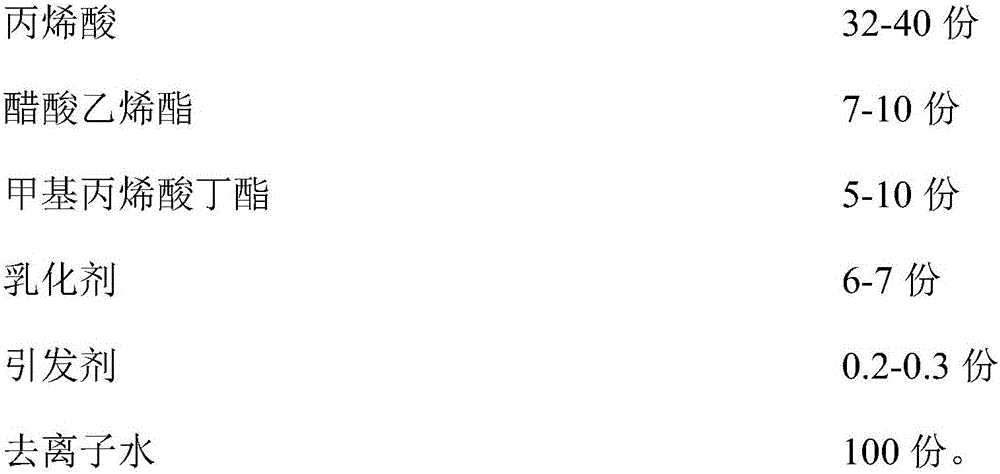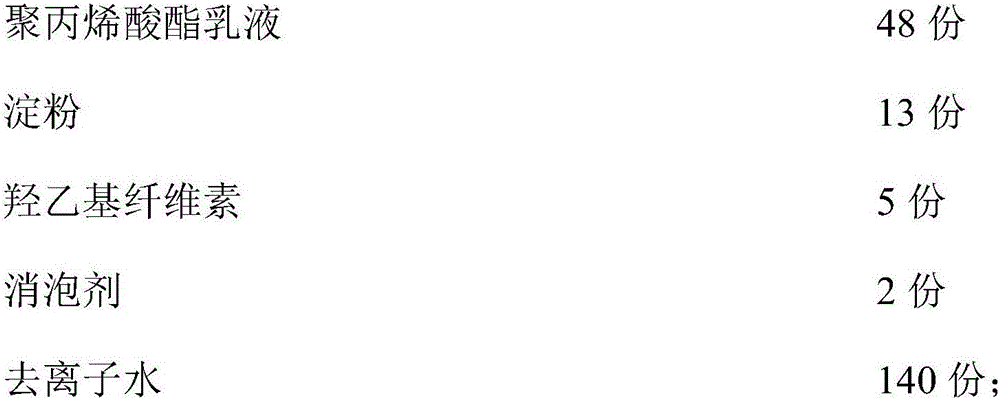Polyacrylic acid spinning sizing agent
A technology of textile pulp and polyacrylate emulsion, applied in the direction of wear-resistant fibers, etc., can solve the problems of hygroscopicity, high re-viscosity, poor fluidity, inconvenient use, etc., and achieve good extensibility, good fluidity, and low viscosity Effect
- Summary
- Abstract
- Description
- Claims
- Application Information
AI Technical Summary
Problems solved by technology
Method used
Image
Examples
Embodiment 1
[0043] A kind of textile slurry, described textile slurry is prepared by following raw material by weight:
[0044]
[0045] Wherein, the polyacrylate emulsion is prepared from the following raw materials in parts by weight:
[0046]
[0047] Described emulsifier is sodium lauryl sulfate.
[0048] The initiator is ammonium persulfate.
[0049] The defoamer is simethicone.
[0050] The preparation method of described polyacrylic acid textile size comprises the steps:
[0051] (1) Mix the polyacrylic acid, vinyl acetate, butyl methacrylate, emulsifier, initiator and deionized water in the formula, and react at 50°C to obtain a polyacrylate emulsion;
[0052] (2) Mix the starch, hydroxyethyl cellulose and deionized water in the formula amount uniformly at 30°C to obtain the first solution;
[0053] (3) Mix the polyacrylate emulsion, the first solution, and the defoamer, heat it to 45° C., and keep it warm for 10 minutes to obtain the polypropionic acid textile slurry. ...
Embodiment 2
[0055] A kind of textile slurry, described textile slurry is prepared by following raw material by weight:
[0056]
[0057] Wherein, the polyacrylate emulsion is prepared from the following raw materials in parts by weight:
[0058]
[0059] The emulsifier is OP-10.
[0060] The initiator is ammonium persulfate.
[0061] The defoamer is simethicone.
[0062] The preparation method of described polyacrylic acid textile size comprises the steps:
[0063] (1) Mix polyacrylic acid, vinyl acetate, butyl methacrylate, emulsifier, initiator and deionized water in the formula, and react at 60°C to obtain a polyacrylate emulsion;
[0064] (2) Mix the starch, hydroxyethyl cellulose and deionized water in the formula amount uniformly at 35°C to obtain the first solution;
[0065] (3) Mix the polyacrylate emulsion, the first solution, and the defoamer, heat to 45° C., and keep it warm for 20 minutes to obtain the polypropionic acid textile slurry.
Embodiment 3
[0067] A kind of textile slurry, described textile slurry is prepared by following raw material by weight:
[0068]
[0069] Wherein, the polyacrylate emulsion is prepared from the following raw materials in parts by weight:
[0070]
[0071]
[0072] The emulsifier is sodium lauryl sulfate and OP-10 with a volume ratio of 1:1.
[0073] The initiator is ammonium persulfate.
[0074] The defoamer is simethicone.
[0075] The preparation method of described polyacrylic acid textile size comprises the steps:
[0076] (1) Mix polyacrylic acid, vinyl acetate, butyl methacrylate, emulsifier, initiator and deionized water in the formula amount, and react at 55°C to obtain a polyacrylate emulsion;
[0077] (2) Mix the starch, hydroxyethyl cellulose and deionized water in the formula amount uniformly at 30°C to obtain the first solution;
[0078] (3) Mix the polyacrylate emulsion, the first solution, and the defoamer, heat to 35° C., and keep it warm for 10 minutes to obtain...
PUM
| Property | Measurement | Unit |
|---|---|---|
| particle size | aaaaa | aaaaa |
| particle diameter | aaaaa | aaaaa |
| elongation at break | aaaaa | aaaaa |
Abstract
Description
Claims
Application Information
 Login to View More
Login to View More - R&D
- Intellectual Property
- Life Sciences
- Materials
- Tech Scout
- Unparalleled Data Quality
- Higher Quality Content
- 60% Fewer Hallucinations
Browse by: Latest US Patents, China's latest patents, Technical Efficacy Thesaurus, Application Domain, Technology Topic, Popular Technical Reports.
© 2025 PatSnap. All rights reserved.Legal|Privacy policy|Modern Slavery Act Transparency Statement|Sitemap|About US| Contact US: help@patsnap.com



